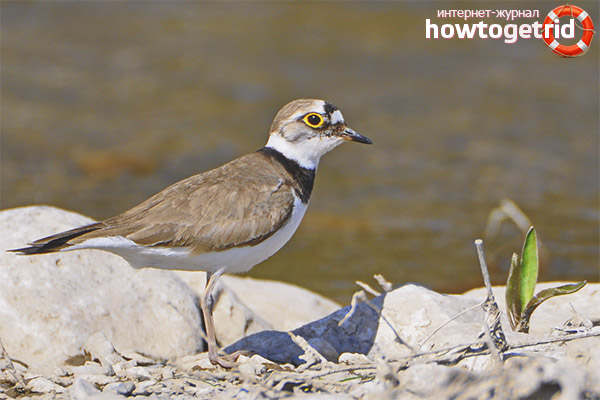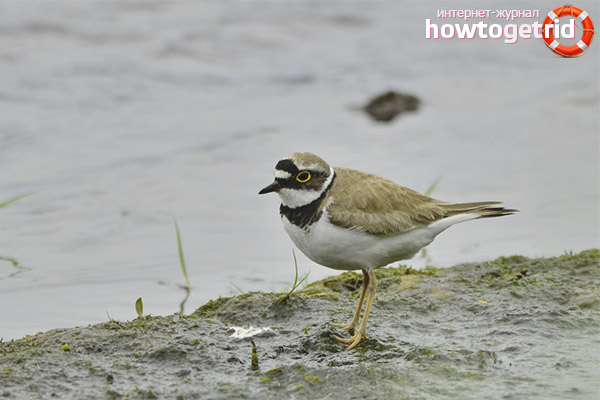The content of the article
There are quite a lot of varieties of hares, all of them differ in distribution places, external data and behavior. At first, these birds were distributed exclusively in Europe, then their habitat expanded to Asia, Africa, China, the Far East and other countries. These inhabitants prefer to settle in brackish or fresh areas.
Species of Bunnies
To date, more than 5 varieties of zuiks are distinguished, including a small one. We will look at everyone in order, so that you have an explicit idea.
Small
- By their overall characteristics, birds grow up to a maximum of 17 cm, but most often individuals are 14–15 cm. The wingspan varies from 43 to 50 cm, and body weight is only 30–50 g. Now it’s clear why these birds were called small.
- A pattern in the shape of a hat flaunts a strip of whitish tone on the back of the head of a zoo. In the front section at the top of the head, the feathers are black. There are yellowish circles in the eye area. In females they are narrow, and in males larger.
- The head is bright in the lower section. In males, a black stripe is in the neck, while in females it is brown. The wings and back are brownish-gray. The trunk and chest are white. The beak is dark, legs are beige, on the paws there are membranes.
- When the cold season comes, the plumage acquires a brownish tone with a light glow. Those circles that are around the eyes are painted in dark. Young individuals are grayish-brown, their cervical stripe is divided into 2 sections.
Nautical
- Seabirds in size do not exceed the dimensions of the sparrow. They are common in brackish or freshwater sources. Relate to migratory, for the winter go to warmer places.
- The back of the males turns gray-brown, the area behind the neck is red, the abdominal part is white, the forehead is light, the strip in the eye area is whitish or beige.
- A distinctive feature is a black mask. Dark spots flaunt on the side of the case. Paws with beak are pigmented in black.
- Females differ from males in that they lack black feathers. In all other respects, they are similar to individuals of male gender. Therefore, it is extremely difficult to distinguish them.
Ussuri
- In terms of overall features, this variety is as small as the previous one, that is, the sizes are comparable to passerines. Individuals live near lakes, rivers and pebble terrain.
- The back is painted in gray tone with brown overtones, and the abdominal region is whitish. In the area of the goiter, that is, at the bottom of the neck, a strip of black flaunts. The dark is dark, the frontal part has a white mark and a black stripe.
- The area above the beak turns black, eyes are edged with a yellow tint. Birds are famous for their sonorous voice, which resembles pilikanie.
Three-lane
- These individuals are larger than their counterparts, they can reach 18 cm in length. They are distinguished by black stripes in the chest area, which are separated by a white mark.
- The bird has red feathers in the eye and beak. As for gender differences, they are not. Young individuals most often stain poorly, they do not have bright colors.
Red Riding Hood
- The body length of the individual in question reaches about 16 cm. In this case, the wingspan can reach up to 32 cm. The weight of the bird is small and amounts to only 40 g. On the abdomen of such a zuyk there is a white plumage. Brown spots can be observed on the back.
- Males have a red color of the neck and head. And only from above. It is because of this characteristic feature that the individual in question got its name. Females have faded color.Their beak is also black.
- Represented birds mainly live in New Zealand and Australia. This zuyuk prefers marshy areas and the banks of calm rivers.
How to distinguish a female from a male
- It is rather difficult to identify gender differences in the considered individuals. Often, many species of zuiks have virtually no differences between females and males.
- Even the size of the individuals remains the same. Only in some species of these birds, females have a weak color of plumage than males.
Breeding
- Small zoo arrive at nesting sites since the beginning of spring. Birds remain until mid-summer. Many factors may also depend on the region where the individuals fly. The colder the area, the later the birds fly here.
- As soon as the birds arrive at the nesting sites, the males immediately begin to separate their territory. After that, the male begins to attract the second half in every way.
- Once the pair has formed, they begin to build a nest. Often the dwelling is located on the coast of pebbles or sand. The nest is a recess with a bed of dry grass. Often, as an alternative, birds use needles, small pebbles and chips.
- At one time, the female can bring up to 4 eggs. They have a whitish color with black or brown spots. Offspring begins to be born after a little less than a month. Both parents are involved in egg-laying. Often they replace each other.
- It happens that the clutch can die completely, in this case, the pair again begins to lay eggs again. Young animals born into the world adapt rather quickly to the environment and begin to show activity. They run and hide well if they notice a danger or potential threat.
- Young growth completely becomes wing, as soon as 1 month is executed. Birds begin to migrate in late summer or early fall. The flight to the southern countries is carried out in small groups. It often happens that individuals migrate even one by one. After wintering, birds often return to their usual nesting places.
Nutrition and Behavior
- It is worth noting that the considered individuals often live at an altitude of 700-800 m above sea level. More than once cases were recorded when birds were noticed even in the Himalayas. At the same time, their habitat height can reach up to 2.8 km. above sea level.
- All kinds of insects, worms and crustaceans often enter the usual diet of a small zuyk. The presented individuals obtain food in most cases in shallow water and open places. Most often, such birds flock in flocks near water, which is full of invertebrates.
Interesting Facts
- During the run of such a bird, one can observe an interesting picture. She takes almost horizontal position. In this case, the individual stops suddenly.
- Such birds even help the breeding pair. Kindred can feed young growth. It is worth knowing that the female immediately leaves the nest after hatching. The male continues to do everything else.
- In the genus of birds under consideration, there are about 30 species. 30% of such individuals often nest on the territory of the Russian Federation. In mating time, the male independently erects a nest and invites the female into it.
The considered representatives of birds are rather interesting individuals with peculiar characteristic features. The little pup is not on the verge of extinction. Virtually nothing threatens such individuals. In addition, these birds have a fairly sharp mind and quick wits.
Video: small snake (Charadrius dubius)












Submit